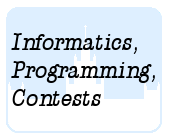Подразделы
Другие разделы
| 1935. Order |
| 1936. Malcolm |
| 1937. Aerodrom |
| 1938. Herkabe |
| 1940. Walnut roll |
| 1941. Essay |
| 1942. Voyager |
| 1943. Infection |
Дата и время
31/12/2025 16:19:12
 1939. Processor
1939. Processor
 Processor
Processor
 Олимпиадные задачи на английском языке
Олимпиадные задачи на английском языке
| 19/07/2013 | Лето 2013-13 (E) |
Ограничения: время – 1s/2s, память – 64MiB Ввод: input.txt или стандартный ввод Вывод: output.txt или стандартный вывод 
Послать решение Blockly Посылки Темы Где Обсудить (0)
Mirko has received an interesting homework assignment: to design his own little processor
(Mirkoprocessor). The processor has `N` registers with indices from 1 to `N`, and each register holds one
unsigned 32-bit integer in the usual binary format (the possible values range from 0 to `2^32-1`).
The processor is capable of executing the following instruction types:
| Instruction type | Description | Example |
| 1 `K` `M` | Rotate the bits of register `K` by `M` positions to the right; write the result back to register `K`. | 00000000000000000010001111111011 –> (M = 1010) –> 11111110110000000000000000001000 (in base 10: 9211 –> `(M\ =\ 10)` –> `4\ 273\ 995\ 784`) |
| 2 `K` `L` | Compute the bitwise XOR of registers `K` and `L`; output the result to the system bus. | 00000000000000000000001111000111 XOR 00000000000001111100000000000111 = 00000000000001111100001111000000 (in base 10: 967 XOR `507\ 911` = `508\ 864` |
Mirko has already built a model of the processor, and only then realized that he'd forgotten to include
an operation to read the contents of a register. Now, his only option is to execute a large number of
type 1 and type 2 instructions and infer the register contents from the results. Having executed a
sequence of commands, he has asked you to help him derive the initial register contents consistent with
the obtained results.
If there are multiple possibilities for the initial register state combination, find the lexicographically
smallest one. (If two combinations have equal values in the first `K\ –\ 1` registers and different values in
register `K`, the lexicographically smaller combination is the one with the smaller value in register `K`.)
The first line of input contains two positive integers: `N` (`2\ ≤\ N\ ≤\ 100\ 000`), the number of registers,
and `E` (`1\ ≤\ E\ ≤\ 100\ 000`), the number of executed instructions.
The remaining input lines describe the instructions in the order that they were executed by
Mirkoprocessor, formatted as described in the table above, one per line. All instructions are legal (the
following conditions hold: `1\ ≤\ K,\ \ L\ \ ≤\ \ N`, `0\ ≤\ \ M\ \ <\ 32`). Each instruction of type 2 is followed by
another line containing a positive integer between 0 and `2^32–1`, inclusive – the result of that operation
(the bitwise XOR value) in base 10.
The first and only line of output must contain the required `N` register values, separated by spaces.
If there is no possible combination of initial values consistent with input, output only the number `-1`, to
notify Mirko that his processor has a bug.
Sample Input #1
3 3 2 1 2 1 2 1 3 2 2 2 3 3
Sample Output #1
0 1 2
Sample Input #2
4 6 2 4 2 3 2 4 1 6 1 3 1 2 3 1 2 1 2 2 2 2 3 7
Sample Output #2
5 0 14 3
Sample Input #3
5 6 2 4 2 10 2 5 3 2 2 2 3 1 2 1 4 3 1 3 1 2 3 4 2147483663
Sample Output #3
15 6 7 12 5

 Начало
Начало